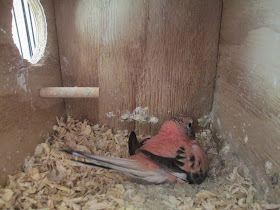So many things to post about and so little time.
 |
There really are five baby Bourkes in this photo.
Red-eyed baby is laying in front of the two in back. |
Our Rosy Bourke, called Rosie, is the sweetest of birds. She and Fuchsia were both on their 3rd clutch of the year and I didn't want them to begin laying more eggs even before their current clutch had fledged ... just knew they would. To prevent that, I removed their youngsters to hand feed and took the nest boxes off their cages.
I'd been hand feeding their babies for a day and a half when the unexpected happened. It looked like my husband was having a stroke and I called 911 for an ambulance. Fortunately, it wasn't a stroke, it's Bel's Palsy, which most people recover from in a few weeks ... thank you, Lord.
However, Wednesday morning proved very chaotic. I had to follow to the hospital. What to do with the hand fed babies!? It seemed highly possible that they might fly my husband to a larger city than our rural community. Even if they didn't, under no circumstances would I get home in time to keep feeding the baby Bourkes. We live a half hour drive one-way to the hospital as it is. I wouldn't leave him and commute back and forth while he was in danger.
As they loaded him into the ambulance he asked if I'd be following. "As soon as I can," I said. Then raced around the house making sure the dog and cat had plenty of extra food and water. Fortunately, I'd already freshened all the birds' waters, but I added extra water bottles to all the cages and gave them all two sprays of millet (that was fastest).
Still, what about the babies?
 |
Hand feeding baby birds, I change their box each time
they're fed. Throw out the paper towel liner, and allow
pine shavings under them to dry from droppings that
soak through the towels. A clean box at each feeding. |
Fuchsia's nest box uses plastic cables to attach it to her cage and my husband puts it up while I hold the box ... not a quick fix.
I decided to trust my sweetest bird, Rosie. Her box has two hooks that allow it to quickly hang from the side, easy to install. I sliced through half the duct tape covering the hole where her nest box had hung and folded it back like a door. Then put the box back on. It hadn't been cleaned yet, but that wasn't much of an issue.
The real issue was, will they re-accept their young after almost two days absence? And, more worrisome, Will Rosie and Pretty Boy accept a foster baby that is already 18 days old? Not even a newly hatched chick? Not only do they need to feed it, they need to not "savage" it as an intruder in their nest ... a potential risk.
Yet, it appeared to be my best option and I put all five babies into Rosie's nest box.
No one was home at our house from early Wednesday morning until late Wednesday evening after my husband was released from the hospital. I immediately checked the babies. All five were stuffed full and contented.
What a wonderful bird is Rosie, our Rosy Bourke hen! And, what a grateful diagnosis for my husband. He may be very uncomfortable for several weeks, but it isn't life threatening. God is good.
I still want to post photos of the two pretty baby Linnies we've had for two weeks now ... that post is coming up next, I hope. If things will only slow down a bit, smile.
Peace & Blessings.

















.jpeg)
.jpeg)

.jpeg)

.jpeg)
.jpeg)
.jpeg)
.jpeg)
.jpeg)
.jpeg)
.jpeg)














.JPG)








